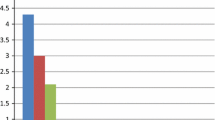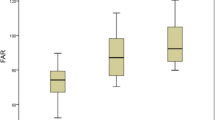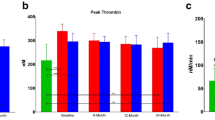Abstract
Background
The slow coronary flow (SCF) phenomenon is characterized by slow progression of angiographic contrast medium in the coronary arteries in the absence of stenosis in the epicardial vessels. The pathophysiological mechanisms of SCF phenomenon remain uncertain. Several hypotheses, however, have been suggested for SCF phenomenon, including an early form of atherosclerosis, small vessel dysfunction, dilatation of coronary vessels, imbalance between vasoconstrictor and vasodilatory factors, platelet function disorder, and inflammation. Atherosclerosis and inflammation are the most accepted mechanisms for the pathogenesis of SCF. Thrombin activatable fibrinolysis inhibitor (TAFI) was described as a new inhibitor of fibrinolysis recently and plays an important role in coagulation and fibrinolysis. In previous studies, the role of TAFI was associated with inflammation and evolution of atherosclerosis in coronary artery disease. There are no data available about TAFI levels in patients with SCF phenomenon investigated by angiography. Our goal was to evaluate TAFI antigen (Ag) levels in patients with SCF and to determine the association of the TAFI Ag level with traditional cardiovascular risk factors in our study.
Methods
The study group constituted 41 patients with angiographically confirmed SCF and 46 patients with normal coronary flow as the control group. The TAFI Ag levels of each patient were determined.
Results
Between the control and study group, a statistical difference in the levels of TAFI Ag (p < 0.05) was observed. The TAFI Ag level was significantly higher in the SCF group than the control group (132.21 ± 21.14 versus 122.15 ± 21.59).
Conclusion
We have demonstrated that TAFI might be a risk factor for the development of SCF independently of conventional cardiovascular risk factors. In addition, TAFI Ag levels were positively correlated with C-reactive protein (CRP) known as an acute phase reactant. Our findings support the reports of previous studies that increased TAFI levels may be associated with inflammation. Further large studies are required to evaluate the importance of TAFI antigen levels in relation to the development of SCF.
Zusammenfassung
Hintergrund
Das Slow-coronary-flow-Phänomen (SCF) zeigt sich daran, dass der Kontrastaufbau bei der Koronararterienangiographie nur langsam erfolgt, ohne dass epikardiale Gefäße stenosiert sind. Die zugrunde liegenden pathophysiologischen Mechanismen sind nach wie vor nicht sicher auszumachen. Allerdings sind etliche Hypothesen zur Entstehung des SCF generiert worden, so u. a. eine Frühform der Atherosklerose, dysfunktionelle kleine Gefäße, dilatierte Koronargefäße, Dysbalancen zwischen vasokonstringierenden und –dilatierenden Faktoren, Thrombozytenfunktionsstörungen und Inflammation. Die am ehesten akzeptierten pathogenetischen Mechanismen sind Atherosklerose und Inflammation. Der erst vor kurzem beschriebene Thrombin-aktivierbare Fibrionlyseinhibitor (TAFI) spielt bei Gerinnungs- und Fibrinolyseprozessen eine wichtige Rolle. Früheren Studien zufolge ist TAFI assoziiert mit Inflammation und der Entstehung von Atherosklerose bei der koronaren Herzerkrankung. Bisher gibt es keine Daten zu den TAFI-Serumkonzentrationen bei Patienten mit angiographisch bestätigter SCF. Ziel der vorgestellten Studie war es, die TAFI-Antigen(Ag)-Level bei SCF-Patienten zu bestimmten und einen möglichen Zusammenhang zwischen TAFI-Ag-Konzentrationen und traditionellen kardiovaskulären Risikofaktoren zu evaluieren.
Methoden
Die Untersuchungsgruppe bestand aus 41 Patienten mit angiographisch bestätigtem SCF, die Kontrollgruppe aus 46 Patienten mit normalem koronaren Flow. Die TAFI-Ag-Konzentration jedes einzelnen Patienten wurde ermittelt.
Ergebnisse
Zwischen SCF- und Kontrollgruppe bestand hinsichtlich der TAFI-Ag-Level ein statistisch signifikanter Unterschied (132,21 ± 21,14 versus 122,15 ± 21,59; p < 0,05).
Fazit
Nachgewiesen wurde, dass TAFI – unabhängig von konventionellen Risikofaktoren – zur Entwicklung eines SCF beitragen kann. Ferner korrelierten die TAFI-Ag-Konzentrationen positiv mit dem C-reaktiven Protein (CRP), das als Akute-Phase-Protein bekannt ist. Beides spricht für die in früheren Studien generierten Hypothesen, dass zwischen erhöhten TAFI-Konzentrationen und Inflammation ein Zusammenhang besteht. Zur Evaluierung der Relevanz von TAFI-Ag-Konzentrationen bei der Entwicklung eines SCF sind weitere, groß angelegte Studien erforderlich.
Similar content being viewed by others
References
Tambe AA, Demany MA, Zimmerman HA, Mascarenhas E (1972) Angina pectoris and slow flow velocity of dye in coronary arteries—a new angiographic finding. Am Heart J 84(1):66–71
Gibson CM, Ryan KA, Murphy SA et al (1999) Impaired coronary blood flow in nonculprit arteries in the setting of acute myocardial infarction. The TIMI Study Group. Thrombolysis in myocardial infarction. J Am Coll Cardiol 34(4):974–982
Mangieri E, Macchiarelli G, Ciavolella M et al (1996) Slow coronary flow: clinical and histopathological features in patients with otherwise normal epicardial coronary arteries. Cathet Cardiovasc Diagn 37(4):375–381
Diver DJ, Bier JD, Ferreira PE et al (1994) Clinical and arteriographic characterization of patients with unstable angina without critical coronary arterial narrowing (from the TIMI-IIIA Trial). Am J Cardiol 74(6):531–537
Cesar LA, Ramires JA, Serrano Junior CV et al (1996) Slow coronary run-off in patients with angina pectoris: clinical significance and thallium-201 scintigraphic study. Braz J Med Biol Res 29(5):605–613
Beltrame JF, Limaye SB, Wuttke RD, Horowitz JD (2003) Coronary hemodynamic and metabolic studies of the coronary slow flow phenomenon. Am Heart J 146(1):84–90
Levin DC, Phillips DA, Lee-Son S, Maroko PR (1977) Hemodynamic changes distal to selective arterial injections. Invest Radiol 12(2):116–120
Kelly RF, Sompalli V, Sattar P, Khankari K (2003) Increased TIMI frame counts in cocaine users: a case for increased microvascular resistance in the absence of epicardial coronary disease or spasm. Clin Cardiol 26(7):319–322
Li JJ, Xu B, Li ZC et al (2006) Is slow coronary flow associated with inflammation? Med Hypotheses 66(3):504–508
Yazici M, Demircan S, Aksakal E et al (2003) Plasma insulin, glucose and lipid levels, and their relations with corrected TIMI frame count in patients with slow coronary flow. Anadolu Kardiyol Derg 3(3):222–226
Eaton DL, Malloy BE, Tsai SP et al (1991) Isolation, molecular cloning, and partial characterization of a novel carboxypeptidase B from human plasma. J Biol Chem 266(32):21833–21838
Cusman M (1999) Hemostatic risk factor for cardiovascular disease. Heamatology 4:236–242
Mosnier LO, Borne PA von dem, Meijers JC, Bouma BN (1998) Plasma TAFI levels influence the clot lysis time in healthy individuals in the presence of an intact intrinsic pathway of coagulation. Thromb Haemost 80(5):829–835
Chetaille P, Alessi MC, Kouassi D et al (2000) Plasma TAFI antigen variations in healthy subjects. Thromb Haemost 83(6):902–905
Schatteman KA, Goossens FJ, Scharpe SS et al (1999) Assay of procarboxypeptidase U, a novel determinant of the fibrinolytic cascade, in human plasma. Clin Chem 45(6 Pt 1):807–813
Silveira A, Schatteman K, Goossens F et al (2000) Plasma procarboxypeptidase U in men with symptomatic coronary artery disease. Thromb Haemost 84(3):364–368
Gibson CM, Cannon CP, Daley WL et al (1996) TIMI frame count: a quantitative method of assessing coronary artery flow. Circulation 93(5):879–888
Pekdemir H, Cin VG, Cicek D et al (2004) Slow coronary flow may be a sign of diffuse atherosclerosis. Contribution of FFR and IVUS. Acta Cardiol 59(2):127–133
Dogan SM, Yildirim N, Gursurer M et al (2008) P-wave duration and dispersion in patients with coronary slow flow and its relationship with Thrombolysis in Myocardial Infarction frame count. J Electrocardiol 41(1):55–59
Avsar O, Demir I, Ekiz O et al (2007) Relationship between the slow coronary flow and carotid artery intima-media thickness. Anadolu Kardiyol Derg 7(1):19–23
Boffa MB, Koschinsky ML (2007) Curiouser and curiouser: recent advances in measurement of thrombin-activatable fibrinolysis inhibitor (TAFI) and in understanding its molecular genetics, gene regulation, and biological roles. Clin Biochem 40(7):431–442
Tregouet DA, Schnabel R, Alessi MC et al (2009) Activated thrombin activatable fibrinolysis inhibitor levels are associated with the risk of cardiovascular death in patients with coronary artery disease: the AtheroGene study. J Thromb Haemost 7:49–57
Redlitz A, Nicolini FA, Malycky JL et al (1996) Inducible carboxypeptidase activity. A role in clot lysis in vivo. Circulation 93(7):1328–1330
Leurs J, Nerme V, Sim Y, Hendriks D (2004) Carboxypeptidase U (TAFIa) prevents lysis from proceeding into the propagation phase through a threshold-dependent mechanism. J Thromb Haemost 2(3):416–423
Schroeder V, Chatterjee T, Mehta H et al (2002) Thrombin activatable fibrinolysis inhibitor (TAFI) levels in patients with coronary artery disease investigated by angiography. Thromb Haemost 88(6):1020–1025
Lisowski P, Malyszko J, Hirnle T et al (2005) Thrombin activatable fibrinolysis inhibitor (TAFI) in stable angina pectoris patients undergoing coronary artery bypass grafting (CABG). Rocz Akad Med Bialymst 50:166–172
Santamaria A, Martinez-Rubio A, Borrell M et al (2004) Risk of acute coronary artery disease associated with functional thrombin activatable fibrinolysis inhibitor plasma level. Haematologica 89(7):880–881
Paola Cellai A, Antonucci E, Alessandrello Liotta A et al (2006) TAFI activity and antigen plasma levels are not increased in acute coronary artery disease patients admitted to a coronary care unit. Thromb Res 118(4):495–500
Eichinger S, Schonauer V, Weltermann A et al (2004) Thrombin-activatable fibrinolysis inhibitor and the risk for recurrent venous thromboembolism. Blood 103(10):3773–3776
Juhan-Vague I, Renucci JF, Grimaux M et al (2000) Thrombin-activatable fibrinolysis inhibitor antigen levels and cardiovascular risk factors. Arterioscler Thromb Vasc Biol 20(9):2156–2161
Aznar J, Estelles A, Tormo G et al (1988) Plasminogen activator inhibitor activity and other fibrinolytic variables in patients with coronary artery disease. Br Heart J 59(5):535–541
Thogersen AM, Jansson JH, Boman K et al (1998) High plasminogen activator inhibitor and tissue plasminogen activator levels in plasma precede a first acute myocardial infarction in both men and women: evidence for the fibrinolytic system as an independent primary risk factor. Circulation 98(21):2241–2247
Sosothikul D, Seksarn P, Pongsewalak S et al (2007) Activation of endothelial cells, coagulation and fibrinolysis in children with Dengue virus infection. Thromb Haemost 97(4):627–634
Wang W, Ji CY, Ye JJ et al (2008) Study of fibrinolysis inhibitors in 117 acute leukemia patients. Zhonghua Xue Ye Xue Za Zhi 29(3):183–186
Wada H NT, Watanabe R, Shiku H, Sakuragawa N (2002) Plasma levels of plasminogen activator inhibitor-1 (PAI-1) and thrombin activatable fibrinolysis inhibitor (TAFİ) in patients with disseminated intravascular coagulation (DIC). Turk J Haematologica 19:235–237
Ermantas N, Guldiken S, Demir M, Tugrul A (2010) Thrombin-activatable fibrinolysis inhibitor (TAFI) antigen and activity assay in patients with primary hypothyroidism. Clin Appl Thromb Hemost 16(5):568–573
Ceresa E, Brouwers E, Peeters M et al (2006) Development of ELISAs measuring the extent of TAFI activation. Arterioscler Thromb Vasc Biol 26(2):423–428
Yazici M, Aksakal E, Demircan S et al (2005) Is slow coronary flow related with inflammation and procoagulant state? Anadolu Kardiyol Derg 5(1):3–7
Li JJ, Qin XW, Li ZC et al (2007) Increased plasma C-reactive protein and interleukin-6 concentrations in patients with slow coronary flow. Clin Chim Acta 385(1–2):43–47
Li JJ, Zheng X, Li J (2007) Statins may be beneficial for patients with slow coronary flow syndrome due to its anti-inflammatory property. Med Hypotheses 69:333–337
Compliance with ethical guidelines
Conflict of interest. M.N. Yildirim, Y. Selcoki, S. Uysal, A.B. Nacar, B. Demircelik, H.I. Aydin, and B. Eryonucu state that there are no conflicts of interest.
All studies on humans described in the present manuscript were carried out with the approval of the responsible ethics committee and in accordance with national law and the Helsinki Declaration of 1975 (in its current, revised form). Informed consent was obtained from all patients included in studies.
Author information
Authors and Affiliations
Corresponding author
Rights and permissions
About this article
Cite this article
Yildirim, M., Selcoki, Y., Uysal, S. et al. Thrombin activatable fibrinolysis inhibitor. Herz 39, 993–1000 (2014). https://doi.org/10.1007/s00059-013-3942-8
Received:
Revised:
Accepted:
Published:
Issue Date:
DOI: https://doi.org/10.1007/s00059-013-3942-8




